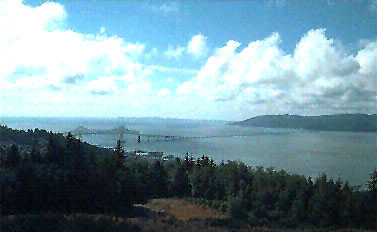Astoria, OregonAstoria, in the northwest corner of Oregon at the mouth of the Columbia River, is the oldest American settlement in the American west, founded in 1811 by John Jacob Astor as a fur trading post.One of the most provincial towns in the world, Astoria's population has leveled at approximately 10,000 for approximately 100 years! Referred to in the past as "Little San Francisco," the Victorian homes on the hills have remained, whereas the downtown area last burned in 1922, the streets having been wood on pilings over the water. Industry from the beginning has been exploitive in fur, salmon, and timber. Astoria is located in Oregon's insular northwest county, Clatsop (named for an Indian tribe), surrounded by river, ocean and mountains. Clatsop County has similarities to the island of Maui: same land area, basic permanent population, large land areas owned by big corporations, indigenous peoples decimated by whites, etc. Astoria has been always a seething cauldron of diversity, from the constant undercurrents of sordidness to the infrequent brilliant bubble bursts of creativity and beauty. A town that could hold both the Ku Klux Klan and the Socialist Party at the same time without too much bloodshed may have something to say for itself. Years of exploitation, racism, prostitution, shanghaiing, and corruption, as well as a few "flower(s) born to blush unseen," accumulate a vast source of material to be dredged by writers, philosophers, and psychologists. Together with European immigrants, in the past, Astoria has had a considerable number of Orientals and East Indians. However, a significant number of immigrants have been Finns and Scandinavians. At one time it was necessary that most clerical help speak Finnish. Clatsop County countryside is somewhat reminiscent of Finland, but more temperate. Only fifty or sixty days of the year Astoria basks in full sun; sixty to seventy days of the year are in partial sun; all the rest of the days of the year- over 200 - the sky is totally obscured with clouds or rain (up to 100 inches per year). |
|
